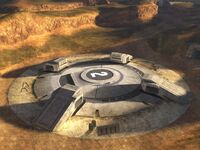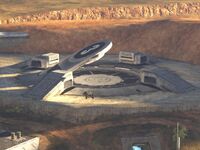- REDIRECT Template:Weapon Infobox
An Intercontinental Ballistic Missile or ICBM is a long-range ballistic missile typically with a range exceeding 5,500 kilometers, typically designed for Nuclear weapons delivery. The UNSC maintains at least one ICBM base equipped with 11-B1 Intercontinental Ballistic Missiles.
Historically, ICBMs have been able to be launched from land-based missile silos, mobile missile trucks, or sea-based Ballistic Submarines. Stationary bases allow easy maintenance and refueling, as well as protecting from military attack and (designers hope) a nuclear first strike. Submarine or truck-launched missiles have the advantage of quick mobility and, in the formers case, stealth, making them difficult for enemy forces to detect and counter quickly enough.
Operation[]

An ICBM Missile Silo closed on the Halo 3 multiplayer map Standoff.

An ICBM Missile Silo half opened for launch.
In flight, a booster pushes the warhead and then falls away. Most modern boosters are solid-fueled rocket motors, which can be stored easily for long periods of time. Early missiles used liquid-fueled rocket motors. Many liquid-fueled ICBMs could not be kept fueled all the time as the cryogenic liquid oxygen boiled off and caused ice formation, and therefore fueling the rocket was necessary before launch. This procedure was a source of significant operational delay, and might cause the rockets to be destroyed before they could be used. To resolve this problem, the British invented the missile silo that protected the missile from a first strike and also hid fueling operations underground.
Once the booster falls away, the warhead falls on an underpowered path much like an orbit, except that it hits the earth at some point. Moving in this way is stealthy. No rocket gases or other emissions occur to indicate the missile's position to defenders. Also, it is the fastest way to get from one part of the Earth to another. This increases the element of surprise. The high speed of a ballistic warhead (near 5 miles (8.05 kilometers) per second) also makes it difficult to intercept.
The high speed can cause the missile to get very hot as it reenters the atmosphere. Ballistic warheads are protected by heat shields constructed of materials such as pyrolytic graphite, and in early missiles, thick plywood. Plywood approaches the strength per weight of carbon fiber/epoxy composites and chars slowly, protecting the missile.[verification needed]
Accuracy is crucial, because doubling the accuracy decreases the needed warhead energy by a factor of four. Accuracy is limited by the accuracy of the navigation system and the available geophysical information.
Strategic missile systems are thought to use custom integrated circuits designed to calculate navigational differential equations thousands to millions of times per second in order to reduce navigational errors caused by calculation alone. These circuits are usually a network of binary addition circuits that continually recalculate the missile's position. The inputs to the navigation circuit are set by a general purpose computer according to a navigational input schedule loaded into the missile before launch.
Trivia[]
- The design currently employed by the UNSC is the 11-B1 ICBM
- If one pays attention to the skies in the Halo 3 level Standoff, you can sometimes see two ICBMs fly across the sky.
Images[]
Appearances[]
- Halo 3 (First appearance)
Sources[]
- Wikipedia's Article on ICBM
- Standoff (level)



